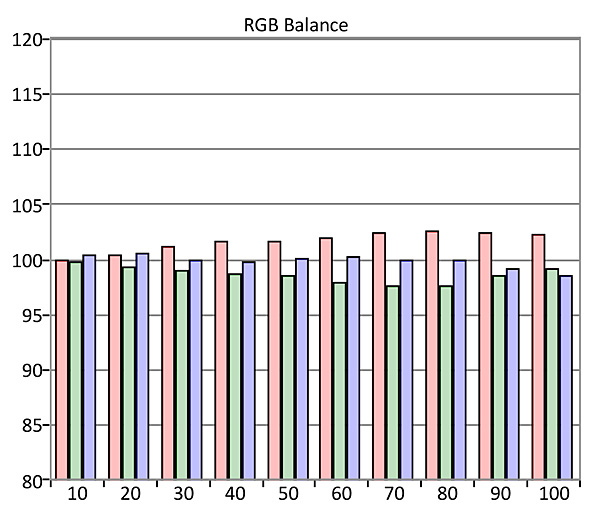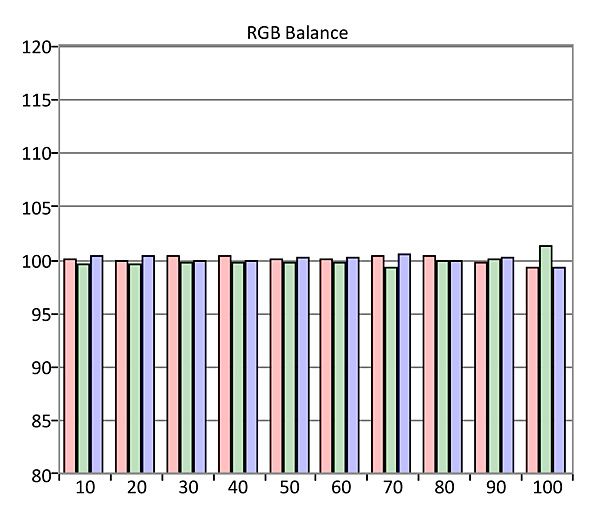Sony Bravia XBR-65A9G OLED Ultra HDTV Review Test Bench
The measurements here were made using CalMAN software from Portrait Displays (www.portrait.com), together with Photo Research PR-650 and Klein K-10A color meters and a Fresco Six-G test pattern generator from Murideo/AVPro.
HD (1080P)/SDR
FULL-ON/FULL-OFF CONTRAST RATIO: unmeasurable
In the Custom Picture Mode, with the Black level control on 50, Brightness on 40 (Max 50) Contrast on 90 (Max 100), Peak luminance on Medium, Gamma at -2, and a 10% full white window, the measured post-calibration peak white level was 165.5 nits (48.3 foot-lamberts). But even our professional-grade Klein K-10A meter gasped to register a black level, consis-tently reading zero for an unmeasurable full-on, full-off contrast ratio.

In the Expert 1 Color temperature setting, the pre-calibration grayscale Delta E (white balance) values ranged from a minimum of 0.94 at 20% to 2.92 at 80%. Post-calibration using only the 2-point grayscale controls, the Delta Es varied from a minimum of 0.24 at 80% to 1.6 at 50%. Before calibration, the color Delta Es varied from a minimum of 1.54 in blue to a maximum of 2.76 in yellow. Post-calibration the minimum was 0.21 in blue and the maximum of 1.7 in yellow. (Delta E is a figure of merit indicating how close the color comes to the D65 HD standard at each point in the brightness range. Values below 3—some experts allow for 4—are generally considered visually indistinguishable from ideal. Above 4 but less than 10, the colors will be visibly changed but generally in ways unobjectionable to the average viewer.)

Post-calibration with the Gamma control set to -2, the Sony's 1080p/SDR gamma produced a result that was slightly dark at the high end of the brightness range. A gamma setting of -1 worked better on most material, varying from 2.31 to 2.39 between 20% to 80%, dropping to 2.0 only at 90%. The final calibration was performed at a gamma setting of -1, but, depending on the source, my viewing preference for SDR varied between -1 and -2.
ULTRA HD/HDR10
FULL-ON/FULL-OFF CONTRAST RATIO: 564,600:1
In the Custom HDR Picture Mode with the Black level control on 49, Brightness on Max, Contrast on 90, Gamma at 0, Peak luminance on High, and a 10% white window, the measured peak white level was 564.6 nits and the black level 0.001 nits, for the full-on, full-of contrast ratio shown above. For an HDR source, however, the majority of the picture information is located at 50% luminance and below, with the range from 50% to 100% reserved for bright highlights. At 50%, the Sony measured 88.3 nits, limiting the contrast ratio for the portion of the picture without bright HDR highlights to 88,300:1.
After calibration (using Sony's automatic use of its look-up tables) the maximum grayscale Delta E with luminance was 4.2 at 70% (and no higher than 2.2 at other levels) and 1.7 at 90% without luminance. The Sony closely followed the HDR PQ curve. Its maximum color Delta E at 50% luminance was 6.6 in red, but no higher than 3.4 in any other color.
As with all OLEDs, the peak white output, most significantly for HDR, varies with how much of the screen is producing a peak white image. A 2% full white window on the 65A9G produced 410 nits, a 5% window 570 nits, a 10% window 560 nits, a 25% window 420 nits, and a 100% window 150 nits.
Using the 1976 standards, the Sony achieved 72.8% of BT.2020 and 97.6% of P3. The image lag at 1080p measured with a Leo Bodnar device was 105ms in the Custom Picture mode and 26.3ms in the Game Picture mode. —TJN




























































